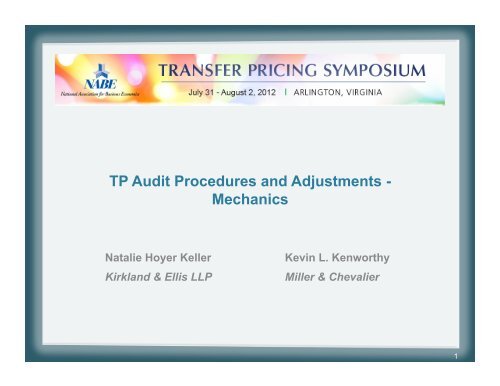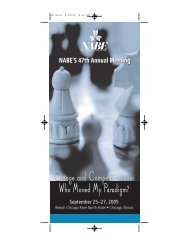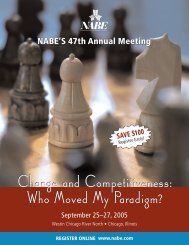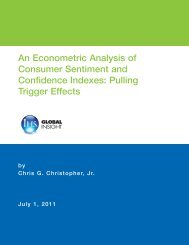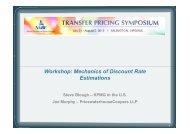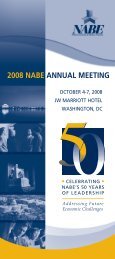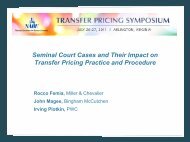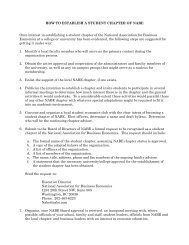slides - NABE
slides - NABE
slides - NABE
You also want an ePaper? Increase the reach of your titles
YUMPU automatically turns print PDFs into web optimized ePapers that Google loves.
TP Audit Procedures and Adjustments -MechanicsNatalie Hoyer Keller Kevin L. KenworthyKirkland & Ellis LLP Miller & Chevalier1
Burden of Proof – General Principles The IRS’s deficiency determination in a civil tax case is generally presumedcorrect, and the taxpayer bears the burden of proof Standard = preponderance of credible evidence The burden of proof may shift to the IRS in certain circumstances, such as: Increase in the amount of the deficiency New matters not included in the Notice of Deficiency Affirmative defenses pled by the IRS (e.g., res judicata, collateral estoppel) The taxpayer also bears the burden of proof in a tax refund suit The taxpayer must establish that there was an overpayment of tax Courts generally will not examine the IRS’s conduct in asserting adeficiency or denying a refund Will not “look behind” notices to examine motives, compliance with administrativeprocedures, etc. Tax cases are generally “de novo” proceedings2
Burden of Proof – Transfer Pricing Cases The IRS’s determination in a transfer pricing case is generally entitled to aheightened presumption of correctness This heightened presumption arises from the broad discretion given to the IRSunder Section 482 To overcome this presumption, a taxpayer generally must show that (i) theIRS abused its discretion (i.e., that the IRS’s Section 482 allocations are“arbitrary, capricious or unreasonable”) and (ii) the taxpayer’s own transferpricing was arm’s length Whether the IRS has abused its discretion is a question of fact As a practical matter, these two burdens are often collapsed (e.g., by showingthat its own pricing was arm’s length, the taxpayer may also establish that theIRS’s allocations are arbitrary, capricious or unreasonable) Courts typically determine their own Section 482 allocations if they conclude thatneither the IRS’s nor the taxpayer’s methodology is defensible, though somecourts have expressed reluctance to do so3
Burden of Proof – Transfer Pricing Cases (cont’d) Because of the heavy burden of proof that taxpayers face in transfer pricingcases, courts may allow taxpayers more leeway to “look behind” the IRS’snotice and examine the IRS’s conduct There are often disputes in transfer pricing cases as to whether the IRShas asserted a “new matter” that shifts the burden of proof to the IRS or,instead, a “new theory” that does not shift the burden These disputes typically arise when the IRS retains new experts for trial whodevelop new theories and methodologies4
Burden of Proof – Transfer Pricing Cases (cont’d) Perkin-Elmer Corp. v. Comm’r, T.C. Memo 1993-414 In the Notice of Deficiency, the IRS based its Section 482 allocations on acharacterization of the taxpayer’s Puerto Rican affiliate as a consignmentcontract assembler Prior to trial, the IRS abandoned this theory and adopted a position thatrespected the affiliate’s status as a licensed manufacturer The taxpayer argued that the IRS’s abandonment of both the factual and legalbases underlying the Section 482 allocations in the Notice caused the IRS’sallocations to be arbitrary, capricious and unreasonable The Tax Court held that the taxpayer met its burden of showing the IRS abusedits discretion, where the IRS’s initial theory had been rejected in other cases The Tax Court held, however, that the taxpayer still must meet its burden ofproving that its transfer pricing was arm’s length “The task thus thrust upon us is, to put it mildly, frustrating. In this case, as inother significant section 482 cases before the Court in recent years, each partyhas spent most of the time attacking the other party’s allocation formula ratherthan establishing the soundness of its or her own formula.”5
Burden of Proof – Transfer Pricing Cases (cont’d) Westreco, Inc. v. Comm’r, T.C. Memo 1992-561 At trial, the taxpayer called as a witness the IRS engineer who determined theinitial Section 482 allocations The taxpayer wanted to question the engineer about the methodology heused to determine the allocations, since the Notice of Deficiency did notexplain the methodology that was used The taxpayer argued that it was entitled to examine the manner in which theIRS exercised its discretion to ascertain whether the IRS abused itsdiscretion The IRS objected to the testimony, arguing that admitting the testimony wouldallow the court to “look behind” the Notice of Deficiency The Tax Court held that a “somewhat broader scope of inquiry is permitted wheretaxpayers have the heavy burden of demonstrating that the Commissioner hasabused his discretion” and allowed the testimony6
Burden of Proof – Transfer Pricing Cases (cont’d) Yamaha Motor Corp. v. Comm’r, T.C. Memo 1992-110 In the Notice of Deficiency, the IRS asserted Section 482 allocations based on itsallegation that the taxpayer had purchased tangible property from its foreignparent at non-arm’s length prices During the pendency of the Tax Court case, the IRS sought leave to file anAmended Answer, in which it asserted that the taxpayer also performedmarketing services for its foreign parent, for which it was not adequatelycompensated The taxpayer filed a motion to shift the burden of proof to the IRS with respect tothe services theory, arguing that it was a “new matter” that would require thepresentation of “different evidence” The Tax Court rejected the taxpayer’s argument, holding that the provision ofservices was sufficiently linked to the tangible property sales so as not toconstitute a “new matter” The Tax Court did, however, shift the burden of proof to the IRS with respectto the applicable mark-up to be applied to the services7
Cleaning Up After a Transfer Pricing Adjustment –Collateral Adjustments Can Have a Significant Impact Correlative Adjustments FTC Interaction Rev. Proc. 99-32 Conforming Adjustments Setoff Claims8
Correlative Adjustments A working definition: Following a primary allocation under section482, consistent allocations made with respect to any other member ofthe controlled group affected by the primary allocation. Treas. Reg.§1.482-1(g)(2). Correlative adjustments are recorded in relevant documentationmaintained for U.S. tax purposes E.g., E&P of a controlled foreign corporation Correlative adjustments are mandatory, even if there is no immediateU.S. tax effect Correlative adjustments are triggered only by a final determinationwith respect to a primary adjustment made to one or more controlledparties9
Simple Example – Correlative AdjustmentIntangible LicenseUSPRoyaltyCFC• Year 1 – CFC pays royalty to USP for intangible license• Year 2 – USP files return for Year 1• Year 3 – IRS determines $100x increase in royalty for Year 1• Then Correlative Adjustment to E&P of CFC for U.S. tax purposes• Potential impact on dividend characterization in Year 1 or futureyear• Potential impact on Subpart F inclusion in Year 1 or future year• Potential impact on section 902 credits10
Interaction Between §482 and Foreign Tax Credits To be creditable, foreign tax must be “compulsory” A tax is not considered compulsory if it exceeds liability under foreignlaw Taxpayers expected to exhaust “all effective and practical remedies”to reduce, over time, foreign tax liability. Treas. Reg. §1.901-2(e)(5). Rev. Proc. 92-75 – Following §482 primary adjustment, §902 tax poolreduced because taxpayer failed to pursue available competentauthority relief Obligation with respect to adjustments related to non-treatycountries?11
Conforming Adjustments A working definition: Following a primary allocation under §482, asecondary adjustment made to rationalize the actual transactionsbetween controlled parties. Treas. Reg. §1.482-1(g)(3). Default rule: a discrepancy between actual and arm’s-lengthtransaction results in deemed capital contribution or dividend, as thecase may be Election: taxpayers may elect to establish a payable/receivablepursuant to an applicable revenue procedure, currently Rev. Proc.99-32 The resulting payable/receivable can be satisfied without further U.S.tax consequences12
Rev. Proc. 99-32 Rules Election to recognize a payable/receivable in the amount of thetransfer pricing adjustment Treated as a debt for all U.S. tax purposes Interaction with §965 Bears interest at arm’s-length rate from the time established untilsatisfied Deemed established on the last day of the taxable year for which anallocation is made If satisfied within 90 days, no additional U.S. tax consequences fromthe repatriation of cash May be treated as pre-paid if offset by bona fide debt or dividendspaid Election not available if transfer pricing penalties imposed13
Dividend Offset Softens the Impact of §482Allocations In some circumstances, otherwise taxable dividends received by aU.S. controlled party are treated as a prepayment of deemed payable/receivable, and dividends excluded from taxable income Under Rev. Proc. 65-17, any dividend paid during the year to whichthe allocation relates could be treated as a pre-payment Rev. Proc. 99-32 limits the utility of the dividend offset For IRS-initiated adjustments, only dividends counted are those madeduring the year in which a closing agreement is finalized For taxpayer-initiated adjustments, eligible dividends are those made in (1)the year to which the primary adjustment relates and (2) the year in which atimely-filed original return is filed reporting the primary adjustment14
Simple Example – Rev. Proc. 99-32 Dividend OffsetIntangible LicenseUSPRoyaltyCFC• Year 1 – CFC pays royalty to USP for intangible license• Year 2 – USP files return for Year 1• Year 3 – IRS determines $100x increase in royalty for Year 1; auditresolved• Year 1 dividends - $30x, Year 2 dividends - $50x, Year 3 dividends -$70x• If Taxpayer initiated adjustment, then Year 1 and Year 2 dividendsmay be excluded• If IRS initiated adjustment, Year 3 dividends may be excluded15
Setoff Claims Taxpayers generally cannot use §482 affirmatively Taxpayers may report the results of a controlled transaction in amanner different than the actual transaction if they do so on anoriginal return. Treas. Reg. §1.482-1(a)(3). But taxpayers also have a limited opportunity to make taxpayerfavorabletransfer pricing adjustments through setoff claims followinga primary adjustment Setoff claim must be submitted within 30 days of the earlier of receipt ofexamination report (30-day letter) or notice of deficiency (90-day letter) Setoff claim may relate to any other non-arm’s-length transaction betweenthe same controlled parties in the same year Taxpayer must establish that the setoff transaction was not arm’s lengthand also establish the arm’s-length price16
Transfer Pricing Information – IRS Toolbox IDRs Traditional Summons – §7602 Designated Summons – §6503(j) Penalty Documentation – §6662(e)(3) Formal Document Request – §982 Foreign-owned corporations – §6038A Foreign corporations engaged in U.S. business – §6038C Treaty Exchange of Information Litigation Discovery Procedures17
Natalie Hoyer Keller Kevin L. KenworthyKirkland & Ellis LLP Miller & ChevalierChicago, Illinois Washington, D.C.312-862-2229 202-626-5848natalie.keller@kirkland.com kkenworthy@milchev.com18


